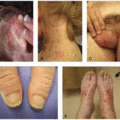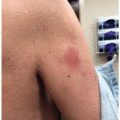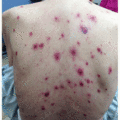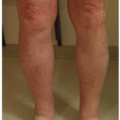Erythroderma
Michelle S. Lee
Vinod E. Nambudiri
Erythroderma is typically defined as diffuse redness affecting over 80% to 90% of the body’s surface area (Figure 11.1). It is a reaction pattern that can be associated with inflammatory dermatoses including psoriasis, atopic dermatitis, pityriasis rubra pilaris, connective tissue diseases (such as systemic lupus erythematosus and dermatomyositis), and malignancy as seen in Sézary syndrome or cutaneous lymphoma. Additionally, erythroderma can also be associated with severe cutaneous adverse drug reactions such as Stevens-Johnson syndrome/toxic epidermal necrolysis (SJS/TEN) or drug-induced hypersensitivity syndrome (DIHS). In such severe reactions, involvement of mucous membranes, including ocular, oral, or genital mucosa, can also be observed. Importantly, in the context of oncologic therapy, erythroderma may be subacute or may represent a severe and potentially life-threatening clinical presentation that requires immediate attention and potential cessation of therapy in patients on anticancer agents.
 Erythema, even when extensive with erythroderma, may present more subtly in patients with darker skin types and can be challenging to appreciate especially when scale is absent. Consider erythroderma in a dark skin patient reporting new diffuse xerosis.1
Erythema, even when extensive with erythroderma, may present more subtly in patients with darker skin types and can be challenging to appreciate especially when scale is absent. Consider erythroderma in a dark skin patient reporting new diffuse xerosis.1Erythrodermic papulosquamous eruptions have been associated with the use of anti-PD-1/PD-L1 agents.2,3 Specifically, both new onset and exacerbation of existing psoriasiform rashes have been reported with anti-PD-1/PD-L1 agents, including widespread pustular psoriasis (Figure 11.2).2 Pityriasis rubra pilaris-like erythroderma has also been reported with anti-PD-1/PD-L1 agents and PI3K inhibitors, presenting with diffuse orange-red plaques and waxy palmoplantar keratoderma (Figure 11.3).3,4 Immune checkpoint inhibitor therapy has been associated with erythroderma, in the form of rarer presentations including extensive lichenoid eruptions, some described as SJS/TEN-like, as well as DIHS.5 Importantly, erythroderma may be a final clinical presentation of nearly any eruption, including morbilliform eruptions secondary to virtually any anticancer therapy.
Stay updated, free articles. Join our Telegram channel

Full access? Get Clinical Tree







